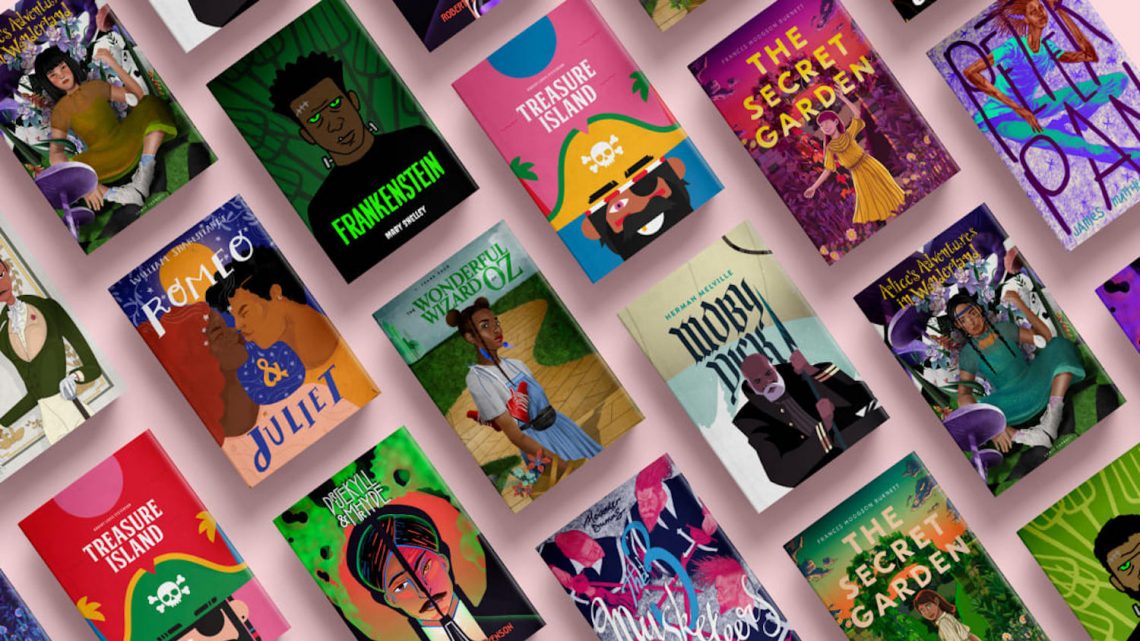
Instead of Highlighting Diverse Authors, This Publisher Just Made Peter Pan Black
February 5, 2020The premise of publisher Penguin Random House's newest editions of "literary classics" is simple: engage readers by portraying main characters as Black or brown on the cover. To that end, the ad agency TBWA/Chiat/Day partnered with the publisher and Barnes & Noble to sell AI-curated "Diverse Editions" of classics in celebration of Black History Month.
In promotional materials shared on Twitter, the project is explained as using artificial intelligence to analyze text from 100 famous titles, "searching the text to see if it omitted ethnicity of primary characters." From those results, twelve books were chosen:
- Alice's Adventures in Wonderland
- The Count of Monte Cristo
- Emma
- Frankenstein
- Dr. Jekyll & Mr. Hyde
- Moby Dick
- Peter Pan
- The Secret Garden
- The Three Musketeers
- Treasure Island
- Romeo & Juliet
- The Wonderful Wizard of Oz
Each of these twelve books were then commissioned five different “culturally diverse” covers where white main characters were reimagined as non-white. Diverse Editions complete!
There are many things wrong with this approach that were only exaggerated by the technology, but let’s start with the most obvious one: how fundamentally lazy it is. These books are filled with problematic depictions of race—take, for example, Peter Pan’s depiction of Native Americans—that don’t suddenly disappear if you change the race of the protagonist on the cover.
One of Frankenstein’s Diverse Editions covers sits at the center of the promotional photo, featuring a Black monster at the center of the promotional picture. Superficially, this might work, but it quickly becomes problematic. The story’s central thrust is that the monster is not human, and through his attempts to make connections we come to see ourselves as the real monsters. With Diversity Edition covers’ shallow engagement of racial identity, and without any sort of effort at a retelling, the story can easily be read as a Huntingtonian tale about irreconcilable cultural differences leading to conflict between a non-white monster and white people.
Or take The Secret Garden which is very, very obviously about a white girl born to British colonialists in India, even if the book never directly describes the color of the protagonist’s skin. It is hard to read the character say things like: "You thought I was a native! You dared! You don't know anything about natives! They are not people—they're servants who must salaam to you. You know nothing about India. You know nothing about anything!" and not think that she is white.
That the list is exclusively filled by British and American authors who are white—save Alexander Dumas—or that it thought diversity was better served by including Shakespeare's Romeo & Juliet as opposed to his Othello, which actually centers a Black character and his experience, suggest that a technological implement was substitute for any effort on their part to understand the texts or their context.
Reading the books, there are very clear contextual clues that these characters are white and can only be white. The fact is that characters in "classics" are assumed to be white because we live in a culture where white is the default, something the Diverse Editions campaign seeks to subvert but instead erases.
Most stories do not describe skin color except to point out a clear difference—white characters do not constantly remark on how white each other's skin is, but they will reliably point out black or brown skin. We are all socialized to understand that if there is no explicit mention then a character is white, precisely because most stories that fill the canon are written by white authors about white experiences for white audiences.
It is mind-numbingly naive to believe that an algorithm can smooth over that racial bias baked into reality, especially when algorithms of every type are rife with racial bias. When this sort of techno-optimism is let loose, it more often than not glosses over or reinforces pre-existing inequities in everything from police surveillance, to housing loans, to employment offers, and now representation. Applied to stories, it does nothing to address real material and ideological reasons why every character is read as white and presents a superficial fix that normalizes this state of affairs as a solution.
There are classic stories which center non-white characters, explore non-white experiences, and are written by non-white authors, so to simply apply such a superficial racial gloss to these books with a cover—not even a retelling—is muddled in reasoning, at best. In the name of diversity, this project erases diversity by pretending the white child of colonial officers can be read as a non-white child, or that a monster created in a lab could be a Black monster.
Obviously, the online backlash was fierce and as a result, the launch event scheduled for Wednesday was canceled.
"The covers are not a substitute for black voices or writers ,whose work and voices deserve to be heard," a statement from Barnes & Noble read. "The booksellers who championed this initiative did so convinced it would help drive engagement with these classic titles."
Therein lies the problem. There already exists a rich canon of non-white literature outside of our large Eurocentric one. Instead of thinking to spend five minutes engaging it, a glitzy ad agency convinced an international publisher and bookseller to take a buzzy shortcut in service of a shallow conception of diversity.
On Twitter, users spent no time sharing multiple alternative lists that do some of the basic work that should’ve already been done. Honestly, if you want to read about race, read a book that does so by design not artifice.

